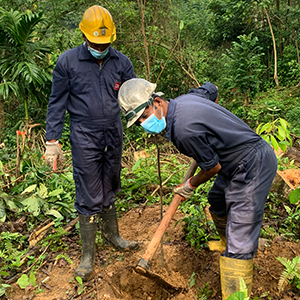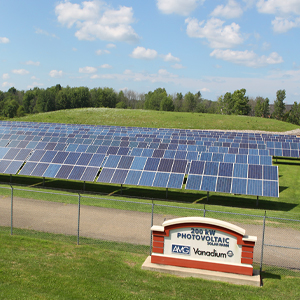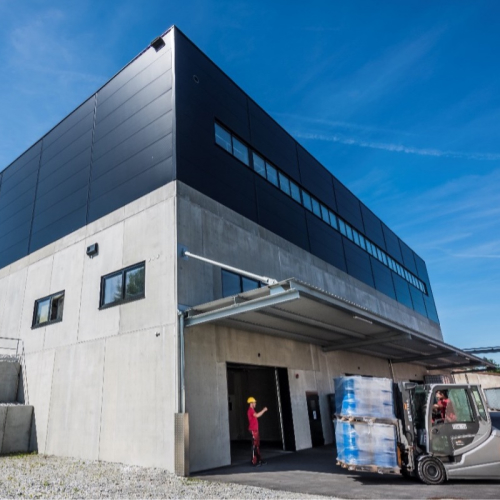AMG is committed to achieving the highest standards of safety and environmental conduct at all its manufacturing facilities, as well as producing materials that help its customers minimize adverse environmental impact. Protecting the environment is directly linked to our focus on sustainable development and support of the UN Global Compact.
AMG’s management approach aims to protect the environment in two specific ways. The first involves serving the green economy by acting as a key link in the supply chain of the advanced materials, recycling, and nuclear industries. Each of these sectors plays a vital role in addressing the ongoing challenges of climate change and waste and pollution reduction. The second involves AMG’s commitment to measuring and minimizing the environmental footprint associated with its own manufacturing operations. Managing our impact on the environment is of the utmost importance to AMG. As a company with low risk tolerance, we manage environmental impacts closely so that they do not develop into significant environmental risks.
AMG has a global footprint and, therefore, our facilities are subject to a variety of compliance obligations. AMG has a Corporate Environmental Committee, which comprises the Vice President of Legal, Vice President of Sustainability, Environment, Health, and Safety, Director of Environmental Projects, and the Director of Risk Engineering. This committee focuses on associated legal liabilities and discrete remediation projects in addition to addressing environmental risks from our business units. Each of our facilities and business units manage their environmental impacts through dedicated Environmental, Health, and Safety teams. Of the 34 facilities, 12 have International Organization for Standardization (ISO) 14001-certified environmental management systems. If an environmental aspect at an AMG site develops into a significant business risk, the business unit notifies the Corporate Environmental Committee for additional support.
Currently, AMG collects and internally audits environmental data from all locations once per year and uses the information gathered to assess potential opportunities for improvement and key performance indicators.
AMG BRAZIL SÃO JOÃO DEL REI—BIODIVERSITY AND ENVIRONMENTAL IMPACTS STUDY
In order to analyze the potential impacts on the local fauna and flora, AMG Brazil São João del Rei carried out a study to assess the environmental quality in the area of influence of the company, gathering information on the abundance and diversity of local species. AMG Brazil São João del Rei has voluntarily preserved a significant vegetation area near the plant, one of the few remaining vegetation fragments in the region. Around the industrial plant, there is a designated reforestation area that is composed mainly of eucalyptus trees. However, the study identified several other native species, indicating that this area is naturally regenerating and diversifying despite being fragmented from other forest areas. The presence of avifauna also indicates a healthy and rich habitat despite the proximity of the forest to an industrial activity. The study concluded good environmental quality and diversity in the surrounding area, indicating that the AMG Brazil São João del Rei does not negatively affect the local fauna and flora and contributes to the preservation of important forest fragments in the region.
We consider our most important responsibility to our stakeholders to be our responsibility to the global community. We feel the best way to measure this is in terms of our contribution to global CO2e reduction. Developing innovative products that enable the reduction of CO2e across the diverse industries we serve is fundamental to AMG’s business strategy. As we carry out this critical work, we closely monitor the emissions that result from our activities and strive for year-over-year reduction in emissions. AMG reports on our facilities’ emissions of both Scope 1 and Scope 2 greenhouse gases (GHGs) and other permitted air emissions, including SOx, NOx, and particulate matter.
Scope 1 GHG emissions result primarily from the combustion of carbon-containing materials as part of the metallurgical process, such as using coke as a reductant. They also result from the generation of heat, such as burning natural gas in a furnace. GHGs from processes other than combustion are minimal. Our innovative production practices for metallurgical processing require significant heat generation from the use of electricity, which is the largest source of AMG’s Scope 2 GHG emissions. In 2021, AMG total CO2e emissions were calculated using Scope 1 GHG and Scope 2 Market Based GHG emissions to reflect renewable energy power purchase agreements. In 2021 AMG’s total Scope 1 and 2 GHG emissions have been calculated based on an operational control approach in accordance with the Greenhouse Gas Protocol Corporate Accounting and Reporting Standard.
Emissions of ozone-depleting substances are generally immaterial for AMG. However, in 2021, AMG Critical Materials Technologies reported air emissions from refrigerants to be 108 metric tons of CO2e. Other pollutant air emissions that result from minor sources, such as heating and hot water boilers, remain immaterial. High-intensity production practices are common in our industry, making it a challenge to reduce emissions substantially. AMG is proud of our management of air emissions and will continue to seek year-over-year reduction in all areas.
Air emissions data from our Environment, Social, Governance, Products Dashboard is shown below.
| METRIC | UNITS | AMG GROUP | |
|---|---|---|---|
| 2020 | 2021 | ||
| Total CO2e emissions | mt | 460,481 | 464,442 |
| CO2e emissions (Scope 1) | mt | 207,656 | 217,002 |
| CO2e emissions (Scope 2: Location-Based) | mt | 252,825 | — |
| CO2e emissions (Scope 2: Market-Based) | mt | — | 247,440 |
| SOx | mt | 407 | 305 |
| NOx | mt | 370 | 153 |
| Particulate Matter | mt | 78 | 53 |
AFFORESTATION DURING COVID-19
During the Pandemic, Bogala Graphite Sri Lanka PLC had excess manpower due to reduced production (less demand). The company launched an afforestation program in a bare land belonging to the company, utilizing the extra manpower available. About 1,500 trees were planted. The project was planned and executed with the guidance of the local Range Forest office.

Improving energy efficiency is an operational priority at AMG that results in environmental and economic benefit. At AMG, electricity and natural gas are the two most significant sources of energy. Seven of AMG’s facilities with the most energy-intensive activities are currently certified to the ISO 50001 standard for energy management systems. Energy management systems provide a formal structure for managing energy use. By promoting energy efficiency, energy management systems help AMG conserve resources, address climate change, and save money.
Energy consumption within the organization, using data from our Environment, Social, Governance, Products Dashboard, is shown below.
| METRIC | AMG GROUP | |
|---|---|---|
| 2020 | 2021 | |
| Total Energy Consumption1 (TJ) | 3,394 | 3,484 |
| AMG Owned Renewable energy generated and consumed (TJ) | 37 | 40 |
| Renewable energy consumed (TJ) | 37 | 170 |
| Percentage of energy consumed that is derived from renewable sources (%) | 1.1 | 4.9 |
| Non-renewable energy consumed (TJ) | 3,357 | 3,314 |
| Percentage of energy consumed that is derived from non-renewable sources (%) | 98.9 | 95.1 |
| Electricity consumed from the grid (TJ) | 2,449 | 2,505 |
| Percentage of consumed electricity from the grid (%) | 93.8 | 93.7 |
- Calculated in accordance with GRI 302-1,2
HYDROELECTRIC & SOLAR ELECTRICITY GENERATION
AMG’s implementation of renewable energy generation at both our Brazil and Ohio sites has resulted in a sustainable form of direct energy and a reduction in our GHG emissions. In 2021, AMG’s hydroelectric generating facility near São João del Rei, Brazil generated 68 TJ of electricity, and AMG Vanadium’s solar power system generated 1 TJ.

AMG GRAPHITE KROPFMÜHL PLANT EFFICIENT BUILDING
Graphite Kropfmühl has taken into service a brand-new production building, which is the new home for the Graphite Dispersion Department. The building is housing a mixing, packaging and storing facility as well as its own laboratory and office area.
This building is constructed according to the latest energy saving standards; roof, walls, windows and doors are highly insulated and large glass panels in the main production area flood the building with plenty of day light. Frost-free storage areas are situated underground and use the natural heat of the embankment against which the building is built. The 2100 m2 hall emits zero CO2 for heating or cooling, as the building uses waste heat from a central compressor station and distribution system on site.

At AMG, we look for ways to eliminate waste and use recycled materials as product inputs to enable the growth of a circular economy. In particular, we innovate processes that allow us to take what was once waste, such as spent refinery catalyst, and extract the critical materials necessary to make our products.
AMG also proactively reviews our manufacturing processes to identify non-sellable product streams for opportunities to innovate these materials into products our customers need. We understand that resource efficiency not only creates good outcomes for our customers but is also far better for our environment. Identifying opportunities for innovation and efficiency is a strategic focus at AMG. We strive to improve and optimize our processes to achieve year-over-year resource efficiency improvements.
AMG VANADIUM – FROM WASTE TO CO2 SAVINGS
At AMG, we look beyond what other companies view as waste and see potential for waste reduction and new product streams. That vision is how AMG’s FEROVAN™ product was developed. Ferrovanadium, an alloy of iron and vanadium, is a universal hardener, strengthener, and anti-corrosive additive for steels such as high-strength low-alloy steel. FEROVAN™ is manufactured in Cambridge, Ohio using spent refinery catalyst that contains vanadium sourced as a waste product from the crude oil refining industry. When blended with steel, FEROVAN™ improves tensile strength and corrosion resistance of steel alloys, as well as delivering environmental benefits due to its lightweighting attributes.
An LCA performed in 2018 suggested that using AMG FEROVAN™ to manufacture vanadium steel rebar could result in a 25 percent or more GHG emissions mitigation benefit when compared with rebar made from a standard carbon steel, enabling our customers to achieve significant carbon reduction in their products.

AMG believes in the responsible and sustainable management of hazardous and non-hazardous waste streams generated by our segments. Our manufacturing sites reuse and recycle waste to conserve natural resources and reduce pollution, but also to create cost-saving opportunities for our business. Waste that is unable to be recycled is disposed in accordance with regulatory requirements at facilities licensed or approved to handle final disposal (e.g., landfill, destruction, etc.) of the specific waste material.
As noted above, AMG processes spent catalyst that was once waste by transforming it into valuable goods which largely eliminates long-term environmental liability for refineries and, so long as it is done appropriately, can eliminate human health, financial, and reputational risks as well. AMG has designed its processes to achieve over 99% conversion of oil refinery wastes to saleable finished goods, while generating no process wastewater. This is likely to eliminate more of the environmental risks associated with land disposal. For spent catalysts in particular, this permanent disposition is much safer than landfill solutions.
Waste within the organization, using data from our Environment, Social, Governance, Products Dashboard, is shown below.
| METRIC | Units | AMG GROUP | |
|---|---|---|---|
| 2020 | 2021 | ||
| Total Waste | mt | 32,839 | 43,007 |
| Total Recycled Waste | mt | 16,836 | 18,635 |
| Percent Waste Recycled | % | 51.3% | 43.3% |
| Hazardous Waste (Including Recycled) | mt | 3,599 | 3,588 |
| Recycled Hazardous Waste | mt | 2,278 | 2,164 |
| Percent Hazardous Waste Recycled | % | 63.3% | 60.3% |
| Non-Hazardous Waste (Including Recycled) | mt | 29,240 | 39,419 |
| Recycled Non-Hazardous Waste | mt | 14,566 | 16,471 |
| Percent Recycled Non-Hazardous Waste | % | 49.8% | 41.8% |
| Waste Directed to Disposal | mt | 16,003 | 24,372 |
AMG views water consumption and water scarcity as global trends that are important to monitor, though AMG’s activities are not significantly water intensive. Using WRI Aqueduct, AMG performed a water risk review of our facilities in 2021 and determined that our site locations are in areas unaffected by significant water scarcity concerns. We plan to revisit this assessment as potential risks emerge to determine if further analysis is required for our facilities in more arid climates.
AMG uses water throughout the mining process as part of mineral extraction and processing activities. After mining activities, most of AMG’s water is used for non-contact cooling purposes and therefore produces clean water discharges.
AMG will continue to look for opportunities to reduce our water consumption year-over-year. Overall, we view the conservation of water in the same way we view all resource reduction: take only what we need. Additionally, minimizing waste is both economically and environmentally beneficial for our Company and our stakeholders. Water usage within the organization, using data from our Environmental, Social & Governance Performance Dashboard, is shown below.
| METRIC | AMG GROUP | |
|---|---|---|
| 2020 | 2021 | |
| Total Water Withdrawn (thousand cubic meters) | 10,669 | 12,655 |
| Total Water Consumed (thousand cubic meters) | 7,711 | 9,327 |
| Total Water Recycled/Reused (thousand cubic meters) | 6,485 | 7,473 |
| Percentage of Water Recycled/Reused (%) | 61 | 59 |
| Total Water Discharged (thousand cubic meters) | 2,958 | 3,328 |
AMG closely monitors wastewater discharges from its mining operations in order to manage quality and volume. AMG facilities record the volumes of aqueous effluents to local water sources, including process water and non-sanitary sewer discharges. AMG uses chemical analysis of the effluent to determine the primary constituents of the water discharges.
AMG makes an effort to comply with all regulatory requirements and implements industry best practices to manage our wastewater and avoid negative impacts on local communities. As with our other environmental compliance obligations, wastewater activities are managed at the site level by compliance specialists who remain up to date on local regulations. AMG has 12 facilities with permitted wastewater activities and our risks are managed through our effective permitted wastewater controls. In 2021, there were no wastewater impacts on local communities or significant spills (defined as a spill that would affect the Company’s financial statements because of the ensuing liability) at any AMG site.
Most of AMG’s water discharge results from global mining operations in AMG Critical Minerals and AMG Clean Energy Materials. The balance of AMG’s water is used for cooling purposes and therefore produces clean (non-hazardous) water discharges that are released in accordance with local regulations. Some processes generate aqueous waste streams, including cooling water used by the silicon metal furnaces and mine water from dewatering pumps. In several locations, mine water is utilized for process water before final discharge.